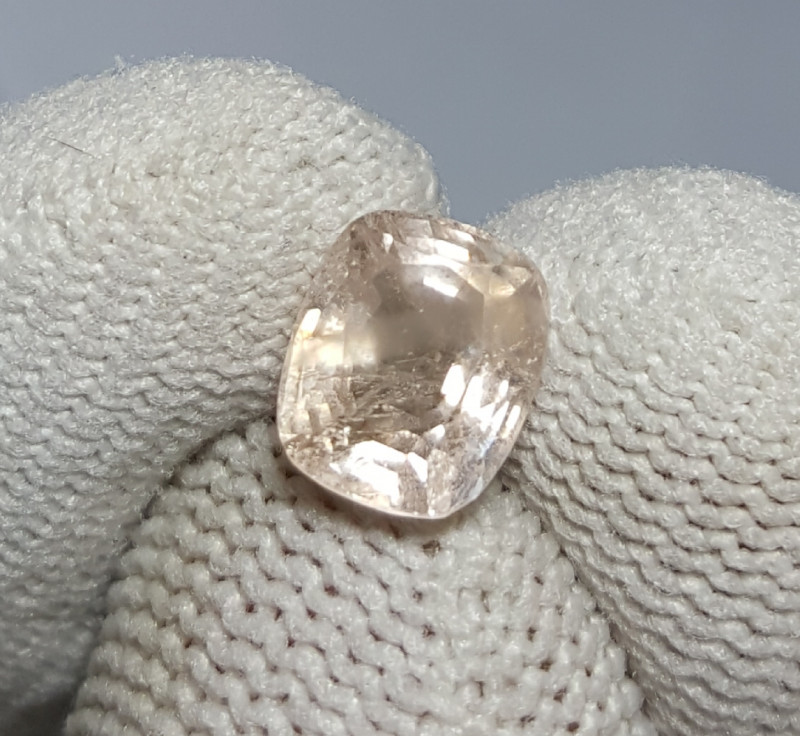
马斯格拉夫石宝石:特性、含义、价值等
 钇铝石是一种塔菲石,发现于澳大利亚,是世界上最稀有的宝石之一。我们甚至将它列入了“史上十大宝石”之列。
钇铝石是一种塔菲石,发现于澳大利亚,是世界上最稀有的宝石之一。我们甚至将它列入了“史上十大宝石”之列。
不幸的是,对于乡村流行乐迷来说,Musgravite 与凯西·马斯格雷夫斯并无关联。但如果你拥有一颗罕见的虹彩宝石,你的头顶上将永远悬挂着彩虹!
想找到属于自己的铍石珠宝吗?只是想了解更多关于这种被许多人称为“稀世珍宝”的宝石的信息吗?敬请关注,了解铍石的价格、特性、优势和历史!

关于 Musgravite Stone
铍铝石是一种通透迷人的宝石,备受稀有宝石爱好者的追捧。但它究竟有多稀有呢?
首先,铍铝镁石比其母石塔菲石更为稀有,后者也是世界上最稀有的宝石之一。自1967年首次发现以来,至2006年,全球仅发现了20颗刻面铍铝镁石。自2005年以来,全球仅开采出8颗(已知的)宝石级铍铝镁石样本。
鉴于铍铝石的稀有性和价格,你可能会想:铍铝石是钻石吗?不,铍铝石是完全不同的宝石。话虽如此,铍铝石作为半宝石的稀有性实际上超过了珍贵的钻石。
虽然“musgravite”是最常用的商品名,但官方名称实际上是“magnesiotaaffeite-6N'3S”,有时简化为“magnesiotaaffeite”。
那么铍镁铝榴石作为一种矿物怎么样?它的特性是什么?
Musgravite 规格和特性
铍铝石是一种铍铝氧化物矿物,属于塔菲石(或称镁硅酸塔菲石)矿物组。塔菲石和铍铝石很难区分——它们的化学式甚至非常相似:塔菲石的化学式为BeMg3Al8O16,铍铝石的化学式为Be(Mg,Fe,Zn)2Al6O12。
铍铝镁石的化学式也可以写成Mg2BeAl6O12。虽然它富含镁,但也含有铍、铝和氧。通常含有大量的铁和锌,也可能含有少量的钙、锰和镓。
塔菲石和铍铝石之间最明显的区别是它们的晶体系统,塔菲石是六方晶系,而铍铝石是三角晶系。
与祖母绿和海蓝宝石等其他含铍矿物一样,铍镁铝榴石也是一种坚硬的矿物。它的硬度甚至略高于绿柱石, 莫氏硬度为8至8.5(而其他绿柱石的莫氏硬度为7.5至8)。
铍铝石是什么颜色?铍铝石通常呈灰绿色至橄榄色,但也有紫色、绿蓝色或近乎无色的色调。塔菲石的颜色范围包括粉色、无色、红色和紫色。
其余铍镁铝榴石矿物数据如下:
莫氏硬度:8-8.5
颜色:通常为灰绿色、橄榄绿色或灰紫色;深绿蓝色、紫色、灰色、无色
晶体结构:三方晶系
光泽:玻璃质(玻璃状)
透明度:半透明至透明
折射率:1.719-1.726
密度:3.61–3.68
解理:[0001] 处完美(或分离),[1011] 处不完美
断口:贝壳状
条痕:白色
发光:通常无,有时荧光 - 长波紫外线下呈弱橙色,短波紫外线下呈弱红色
多色性:无
双折射率:0.007
从矿物学角度来看,我们来换个角度看看铍铝石的形而上学和历史方面。
 图片来源:DonGuennie(G-Empire The World Of Gems)| Creative Commons Attribution-Share Alike 4.0 International 许可证
图片来源:DonGuennie(G-Empire The World Of Gems)| Creative Commons Attribution-Share Alike 4.0 International 许可证
穆斯格拉夫特的含义和历史
从马斯格拉夫特水晶的象征意义来看,这种水晶象征着各种喜悦。其主色调绿色也象征着新的开始、平衡和个人成长。
“马斯格雷夫石” (musgravite) 的名字源于其1967年被发现的地点:南澳大利亚的马斯格雷夫山脉。由于其含有镁元素且与塔菲石 (taaffeite) 存在关联,国际矿物学会 (IMA) 将这颗澳大利亚宝石重新命名为 magnesiotaaffeite-6N'3S。
起初,矿物学家认为在马斯格雷夫山脉(具体来说是在埃尔纳贝拉传教站)发现的石头是某种塔菲石。经过严格的测试,马斯格雷夫石被正式认定为一种新矿物。
随着这一新品种的消息传开,收藏家和宝石学家开始检测那些被标记为塔菲石的宝石。然而,在1993年至2000年间,只有两颗被明确鉴定为铍格拉夫石。
即使是因制定钻石 4C 分级标准而闻名的美国宝石学院 (GIA) 的宝石学家,直到 1997 年才见到刻面铍铝石。
21世纪的马斯格雷夫特
截至2006年,已确认约有20颗刻面铍铝石宝石。加拿大宝石学家默里·伯福德(Murray Burford)已鉴定出其中3颗。这个数字看似不大,但从数学角度来看,伯福德鉴定出了全球15%的铍铝石宝石,功不可没!
2005年以后,斯里兰卡、马达加斯加、坦桑尼亚、格陵兰岛,甚至南极洲都发现了新的铍铝石(尽管数量很少)。
2007年,瑞士古柏林宝石实验室宣布发现已知最大的铍铝石,这则重磅新闻(一语双关)轰动了宝石界。这颗灰紫色的宝石呈心形,多面切割,重达16.05克拉。2021年,它以80万美元的价格售出。
自2007年以来,人们发现了更大的铍铝镁石。目前已知最大的铍铝镁石被称为“俄斐大铍铝镁石”,重达214克拉!
除了创下世界纪录之外,铍镁还有什么用途?
 图片来源:DonGuennie(G-Empire The World Of Gems)| Creative Commons Attribution-Share Alike 4.0 International 许可证
图片来源:DonGuennie(G-Empire The World Of Gems)| Creative Commons Attribution-Share Alike 4.0 International 许可证
穆斯格拉夫特的治疗功效
所有宝石和水晶,包括铍铝石,都可以用作疗愈石。虽然铍铝石的储量不足以广泛用于水晶疗愈,但它仍然具有疗愈功效——其中一些功效源于其独特的颜色。
常见的绿色马斯格拉夫石,如同其他 绿色宝石一样,象征着情感平衡、与自然的联系以及繁荣昌盛。此外,这些宝石也是极佳的脉轮石,有助于打开心轮,激发自爱和接纳。
铍铝石的紫色色调让人联想到紫色宝石的益处,带来精神智慧和启迪。
灰色底色甚至可以带来新的力量,例如灰色宝石固有的稳定情绪和提高注意力的功效。
据称铍石的其他治疗用途包括:
缓解压力
增强乐观和积极性
促进各领域的成功(例如工作、人际关系、健康)
带来内心的平静
说到内心的平静,您可能担心在购买像铍铝石这样稀有(因而价格昂贵)的宝石时被骗。为了帮助您安心做出决定,我们接下来将探讨铍铝石需要注意的因素。

马斯格拉夫特宝石属性
除了普遍的稀有性之外,单颗铍铝石的价值还取决于其颜色、切工、净度和克拉重量。
颜色
马斯格拉夫石的颜色并非其价值的最重要因素,但仍然意义非凡。这种宝石的颜色可以是绿色、紫罗兰色或紫色,有时还带有灰色底色。
铍镁铝榴石呈现绿色的原因很可能是石头中含有铁。
无色和红色的标本相当罕见,但最有价值的铍石颜色是紫色。
切
由于铍铝石极其稀有,几乎所有宝石都经过刻面处理,以提升价值。目前已鉴定的少数铍铝石宝石中,常见的刻面形状包括垫形、椭圆形和梨形。
明晰
净度是指宝石中可见内含物的数量,会影响宝石的透明度和闪光度。透明、无瑕疵(肉眼无可见内含物)的铍镁铝榴石宝石价值最高。
在铍镁铝榴石中发现的一些内含物包括:
大而圆形的磷灰石晶体
小而无色的针状物
不透明、黑色、六角形石墨片
GIA于2015年研究了一颗极为罕见的铍铝镁铁矿,由于蚀刻管与宝石晶体结构一致,呈现出薄膜虹彩。尽管这颗小宝石仅重0.85克拉,但却是已知唯一一颗呈现光学现象的铍铝镁铁矿。
克拉重量
虽然大部分出售的铍石重量不足5克拉,但也有一些更大的。在四颗最大的铍石中,美国公司Ophir Collection LLC拥有三颗。除了历史部分讨论过的那颗16.05克拉的铍石外,目前已知的另外三颗最大的铍石是:
俄斐红铍铝石:最大的红铍铝石,重 21.07 克拉
俄菲尔铍铝石:曾是最大的切割铍铝石,重 22.64 克拉
Ophir Grand Musgravite :目前最大的切割 Musgravite,重 214 克拉
撇开尺寸不谈,铪玻璃石最初是如何形成的呢?
马斯格拉夫特岩的形成和来源
作为塔菲石的一种,铍铝镁铁矿很可能产于类似的环境中:冲积层、沉积物和沉积岩。铍铝镁铁矿具体产于哪种岩石中?
由于许多铍铝镁石是从刻面宝石中鉴定出来的,它们的过去多少有些神秘。第一颗铍铝镁石是在蓝宝石、尖晶石和金云母附近发现的。
最近发现的新矿床(在格陵兰岛)位于片麻岩基底(大量沉积岩下面的岩石)内的方解石大理岩中。
采矿地点
自1967年发现以来,至2005年,铍格拉夫石仅在澳大利亚发现。目前,在以下地区也发现了少量铍格拉夫石:
南极洲
格陵兰
马达加斯加
缅甸
斯里兰卡
坦桑尼亚
上述来源每年生产的铍铝石宝石不超过 5-10 颗。
考虑到迄今为止讨论的所有有关其稀有性的因素,铍石的价值是多少?
 图片来源:David Hospital | Creative Commons Attribution-Share Alike 4.0 International 许可证
图片来源:David Hospital | Creative Commons Attribution-Share Alike 4.0 International 许可证
Musgravite 价格与价值
正如您可能预料的那样,每克拉的铍镁石价格很高,通常比钻石等许多珍贵宝石的价格还要高。
虽然有些宝石的价格约为每克拉 6,000 美元,但大多数刻面铍铝石宝石的价格为每克拉 30,000 至 35,000 美元。
然而,尺寸更大的宝石也可能卖得更高。例如,来自斯里兰卡的一颗16.05克拉的钇铝石以80万美元的价格售出,每克拉价格略高于49,800美元。
换个角度来看,一颗1克拉的白钻石通常售价在1,300美元到16,500美元之间,大多数价格在4,400美元到7,600美元之间。(由于是1克拉,所以每克拉的价格与宝石的总价相同。)即使是以最昂贵宝石之一而闻名的坦桑石,平均每克拉的价格也只有1,200美元。
在结束之前,让我们来谈谈正确的宝石护理。
穆斯格雷夫特的保养和维护
虽然铍铝石具有良好的抗刮擦性,但其完美的解理结构使其容易因重击而破裂。为了防止这种情况发生,我们建议为所有珠宝,尤其是像铍铝石戒指这样较为脆弱的珠宝,进行保护性镶嵌。
幸运的是,清洁铍石非常简单。小心不要掉落,用软牙刷蘸取温水和温和肥皂混合物轻轻擦洗即可。清洁干净后,冲洗掉肥皂残留物,并用柔软的超细纤维布擦干铍石。
我们建议将您的铍铝石宝石与其他宝石分开存放,以避免您的收藏中的任何宝石被刮伤。
被马斯格拉夫特迷住了吗?
钇铝石是稀有宝石爱好者和水晶爱好者梦寐以求的宝石。虽然目前发现的钇铝石数量不多,但这种情况未来可能会有所改变。
就在2022年7月,矿工们在格陵兰岛发现了一处新的矿床。谁知道未来铍铝石会在哪里出现呢?只有时间才能给出答案。目前,我们可以欣赏这颗宝石的美丽和稀有。
想为您的收藏增添最稀有的宝石吗?立即购买铍铝石宝石!
搜索Gemstone Encyclopedia
最新的文章
棕榈象牙雕刻,又称植物象牙,是象牙的天然替代品,取自南美洲棕榈树(Phytelephas palm)的果实,并以符合伦理的方式采集。本指南将带您全面了解棕榈象牙!
15th Jan 2026
彩虹格纹日光石是一种长石,由于内部含有各种包裹体,呈现出三种绚丽的光学效应。它绚丽多彩的光泽和格纹图案使其成为收藏家梦寐以求的珍宝!
12th Jan 2026
文章分类
How To's is where you will find helpful articles from gem Rock Auctions on how to cut gemstones, select gemstones and buy gemstones.
9文章数

